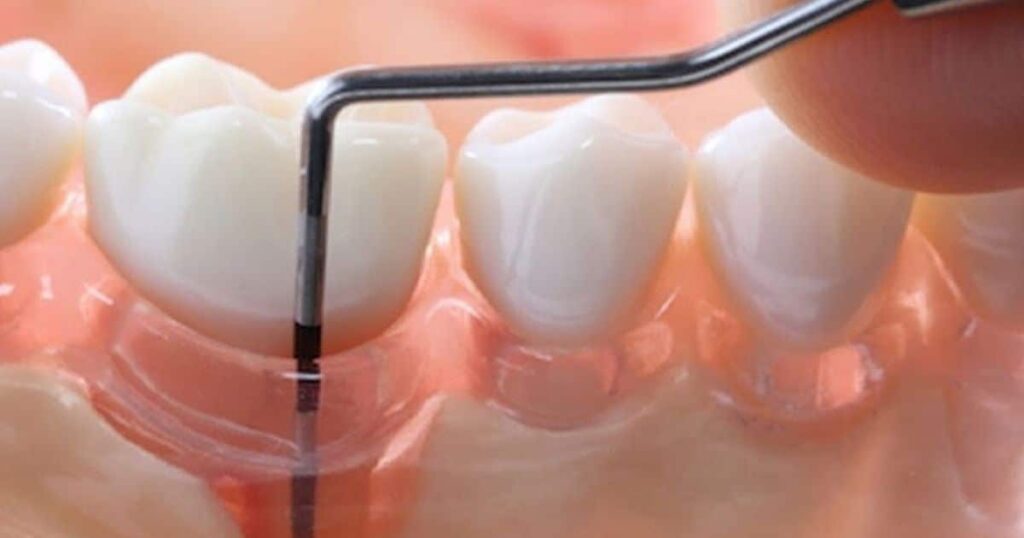In the US, more than 50% of adults suffer from periodontal disease, generally known as gum disease. Some people have inflammatory gums, while others have tissue and bone supporting their teeth damaged. Tooth loss will occur if periodontal disease is not treated in a timely manner. There is a popular query: How long can you keep your teeth with periodontal disease?
It is simpler to prevent other diseases like diabetes and heart disease when one’s dental health is maintained. We can prevent or treat periodontal disease to help safeguard teeth and gums for life.
Gingivitis and periodontal disease signs and symptoms

Gums that are in good health are pink and firm, and they shouldn’t bleed when you brush or floss. Bacteria-filled plaque, a hard-to-see film, builds up on the teeth daily. These plaque-related bacteria can irritate and inflame the gums if improper brushing leaves them on the teeth. Periodontal disease may gradually impact the supportive tissues and bone, which starts at the gum line.
The earliest and mildest stage of periodontal disease, gingivitis, can result from bacterial accumulation. It results in symptoms such as ongoing bad breath, redness and swelling of the gums, uncomfortable biting, dental sensitivity, and gum recession, which lengthens the appearance of the teeth. Gums that have gingivitis also bleed freely. With regular dental cleanings, antimicrobial mouthwash, and daily brushing and flossing, patients can frequently reverse the early stages of gingivitis.
Even while gingivitis is a non-destructive form of periodontal disorder, if it is left untreated, it can worsen. The accumulated plaque eventually hardens into tartar, which can only be removed by a skilled cleaner. The gums may split from the teeth if tartar accumulates below the gum line. Further harm may result if the disease spreads to the underlying bone.
The most severe stage of periodontal disease is called periodontitis. When gingivitis is left untreated, and infection develops, it happens. It may result in tooth loss, uncomfortable chewing, additional gum and tooth separation, bleeding gums, and other health issues. Periodontitis eventually has the potential to destroy the bones, connective tissues, and gums that support the teeth.
The symptoms of periodontitis can seem more severe than those of gingivitis. Symptoms include:
- Tooth shifting or loosening
- Modifications to the way teeth bite together
- Pus between teeth and gums
- Bleeding
- Adjustments to the fit of partial dentures.
How long can you keep your teeth with periodontal disease?
Gingivitis might begin mildly and initially go unnoticed, but it can eventually cause gum inflammation and other unpleasant symptoms. With time, stress has a significant role in the susceptibility to periodontal disease due to its ability to inhibit the immune system. Patients may also notice deepening spaces between the gums and teeth and bone loss due to old age or disease. Despite the fact that every patient is unique, advanced and untreated periodontitis can ultimately result in tooth loss.
One of the complications of periodontal disease is tooth loss. Other bodily parts may be impacted by the harm-causing bacteria that enter the blood through the gums. Periodontitis has been linked to disorders like diabetes, coronary artery disease, and respiratory illnesses.
For the rest of your life, with the proper oral hygiene routine and maintenance, not everyone who has periodontal disease loses their teeth. The following are some facts:
- Half of the participants (300 people) in a 1978 research of 600 patients with periodontal disease did not lose any teeth at all.
- 199 persons had lost one to three teeth, 76 had lost four to nine, and 25 had lost ten to twenty-three teeth.
- Of the 600 participants in the study, 666 of the 2139 teeth were lost.
In conclusion, throughout a 22-year study period, 31% of periodontal disease patients lost their teeth, while just 50% of all participants lost any teeth at all!
Only 61 of the 156 patients in a 2003 study that looked at tooth loss over a 12-year period had at least one tooth lost or extracted. This is essentially in line with the earlier study’s results, in which tooth loss occurred in 50% of patients.
Unexpectedly, one-third of all adults over 65 had lost six or more teeth. The causes of tooth loss, however, are not usually linked to gum disease. Tooth loss can result from cavities and tooth decay.
What are the reasons and risk factors for periodontal disease?

Probably the most significant risk factor is stress. The body’s immune system can be impacted by both physical stress, such as teeth grinding, and mental stress.
- A Significant Risk Factor is Smoking or Chewing Tobacco
- Systemic diseases include diabetes or illnesses that compromise immunity
- Poor oral hygiene
- Cancer treatment
- Pregnancy
- Malnourishment
- Medication
- Obesity
Is periodontal disease reversible?
Patients with less severe gingivitis can learn how to prevent periodontal disease at home by practicing good dental hygiene. A dental intervention will probably be required if gingivitis persists or progresses to periodontitis.
Initial dental care and follow-up care at home are two examples of treatments. A dentist might advise scaling and root planing, for instance. Root planing can smoothe the surfaces of the roots. It will help to reattach gums to the teeth, whereas scaling entails removing tartar below the gum line. The two procedures together eliminate bacterial buildup and promote gum healing. Scaling and root planing could need multiple dental visits and it depends upon the severity of the damage. To detect and treat recurrences, patients may need follow-up visits.
Some periodontitis sufferers may require the assistance of a dentist skilled in reducing gum pockets. Tartar is removed from the spaces using surgical pocket reduction or flap surgery. Before stitching the gums, the surgeon also pulls them to completely clean them. In addition to reducing or eliminating the pockets, this technique also stops further infections. A dental surgeon can conduct a gum graft to rebuild the lost tissue when there are insufficient amounts of gums.
Some cases of advanced periodontitis, which typically result in tooth loss, cannot be treated by surgery. Patients in these situations can choose dental implants to restore their smiles and basic activities like talking and eating. With careful at-home maintenance and routine dental checkups, implants can last a lifetime and look completely natural.
Prescription drugs can relieve symptoms and treat advanced periodontitis in addition to surgery. A dentist can use antibiotics or antimicrobial medications to stop the spread of periodontal disease and target the bacteria.
Although many people can learn how to reverse gum disease, prevention is still the best course of action. A continuous oral hygiene regimen that includes twice-day electric toothbrush use and daily flossing can greatly reduce the risk of developing periodontal disease and the eventual loss of teeth. Additionally, people could regularly use an antiseptic mouthwash. A routine for oral hygiene should also include eating a balanced diet and visiting the dentist on a regular basis.
Frequently Asked Questions
Q. If I have periodontal disease, would I eventually lose my teeth?
Periodontitis, often known as gum disease, is a dangerous gum infection that damages the soft tissue surrounding teeth. Its pronunciation is per-e-o-don-TIE-tis. The bone that supports your teeth could be destroyed by periodontitis if left untreated. This may result in tooth loss or tooth loosening.
Q. Can someone with periodontal disease live a long life?
Avoid becoming discouraged! If you manage periodontal disease with therapy and advice from your dentist, you can live a long life with the problem. As with any chronic ailment, your chances of treating gum disease and enhancing your quality of life are better the earlier you seek treatment.
Q. How old is the onset of periodontitis?
Adults aged 30 and older who have periodontal disease have a prevalence of 47.2%. Age-related increases in periodontal disease are observed; 70.1% of persons 65 and older have the condition.
Final Verdict
In conclusion, the duration for which one can retain their teeth when affected by periodontal disease varies significantly depending on various factors, including the severity of the disease, individual oral hygiene practices, and prompt treatment. While periodontal disease is a serious condition that can lead to tooth loss, it is not an absolute sentence for losing your teeth. With diligent oral care, regular dental check-ups, and timely intervention, many individuals can preserve their teeth for a considerable period, even with periodontal disease.


